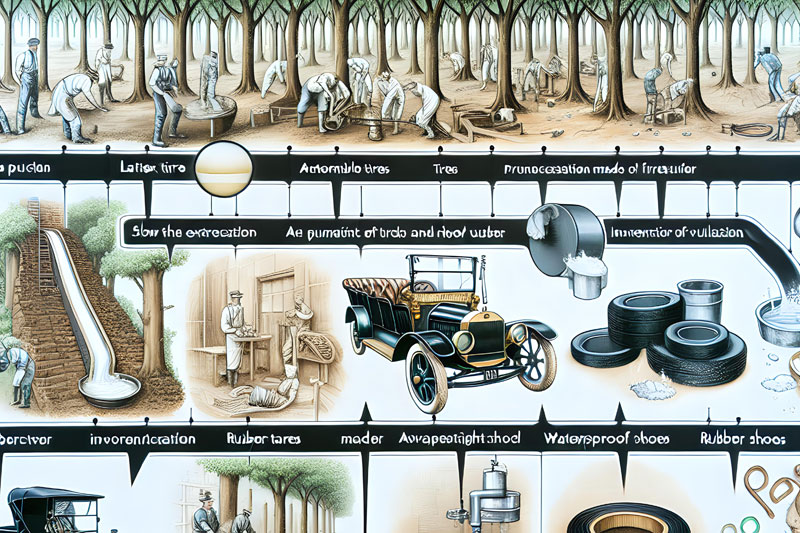Rubber: A comprehensive look at the material that changed the world
Introduction
Rubber is one of those materials that accompany us throughout our lives without perhaps realizing its enormous impact on our daily existence. From flexible shoes, to suspension wheels on bicycles, the automotive industry - e.g. silent blocks - to rubber seals - rubber is all around us.
What is rubber?
Rubber is an elastomeric material, that is, it has the ability to elastically deform and return to its original form after removal of stress or deformation. It is produced either from natural sources, especially latex from the rubber tree, or by synthetic methods that involve chemical modification of polymeric substances.
Rubber equals the word Guma in Czech, the word Guma was derived from the German term for gumming - "Gummi",
Natural rubber
Natural rubber is obtained from a white liquid - latex, which is collected from the rubber tree (Hevea brasiliensis). Latex is obtained through the process of cutting the bark of a tree and then collecting the liquid in a bowl. After collection, the latex is processed to remove water and impurities, and the resulting material hardens.
Synthetic rubber
Synthetic rubber, on the other hand, is created chemically, usually through the polymerization of petrochemical derivatives. The best-known synthetic rubbers include neoprene, developed in the 1930s, and styrene-butadiene rubber ( SBR ), which is commonly used in tires and other applications.
History of rubber processing
Origin in South America

The history of rubber began in the ancient forests of South America, where the original inhabitants - Indians, used it to produce durable and flexible objects. This skill was introduced to European explorers in the 18th century when Charles Marie de La Condamine brought samples of rubber to Europe.
At the time, the monopoly on rubber tree cultivation belonged to Brazil, but the seeds were also caught in Asia, which enabled the subsequent spread of latex to industrialized Europe.
Arrival in Europe and the Industrial Revolution
The arrival of rubber in Europe brought new possibilities. During the industrial revolution, rubber factories began to open, improving the processing of rubber and looking for new uses. The first major discovery was vulcanization, discovered by Charles Goodyear in the mid-19th century. Vulcanization consisted of adding sulfur to the rubber and then heating it. This greatly improved the strength, elasticity and durability of the rubber, opening the door for its wider use.
Before the era of vulcanization, pure rubber broke in the winter and melted in the summer - this greatly limited the use of rubber in, for example, the clothing industry as a means of preventing rain.
Rubber in the 20th and 21st centuries
In the 20th century, synthetic variants of rubber appeared, which brought new possibilities in the field of innovation and production. Research in materials and technology has led to the creation of rubbers with well-defined properties for specific applications, from tires to clothing and medical devices.
Today's rubber is used in a wide variety of industries. The automotive industry could not exist without it, tires are an example of the most extensive application of rubber. The healthcare industry uses rubber in the production of various aids, be it gloves or elastic bandages.
Innovation and the future of rubber
Current research is aimed at creating rubber with even better properties, especially in the areas of sustainability and ecology. We are looking for a way to minimize the environmental impact of rubber, from the source of raw materials to the methods of its processing and recycling.
The development of autonomous vehicles, electric cars and new technologies opens up further opportunities for innovation in rubber. New combinations of materials can deliver rubber with improved durability, resistance and even conductivity not just for electric cars.
Did you know that even ordinary dandelions contain latex? Yes, it's the familiar white liquid that comes out when you pluck a dandelion. However, this latex is not industrially processed - the yield would be minimal.
From its humble beginnings in the ancient forests of South America to its modern synthetic variants, rubber has become a key material that has shaped industry and everyday life. Its unique properties, such as elasticity, durability and versatility, make it an essential part of our world. Although its history stretches back centuries, there are endless possibilities for innovation and improvement that can change our future use of rubber and take us into new realms of sustainability and performance.
FRAM spol.s ro
Třemošnická 358
257 26 Divišov
Benešov district
ID number: 00472875
VAT number: CZ00472875
+420 774 768 975
If you want to become our regional dealer, don't hesitate to contact us!




